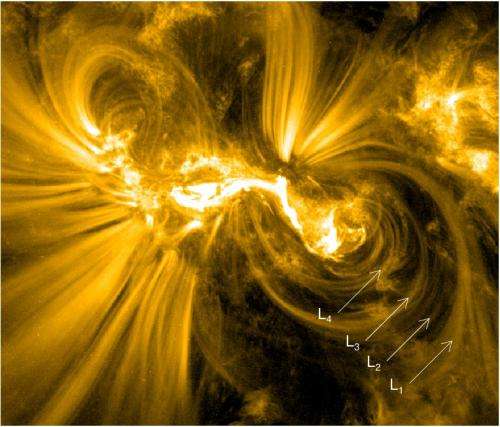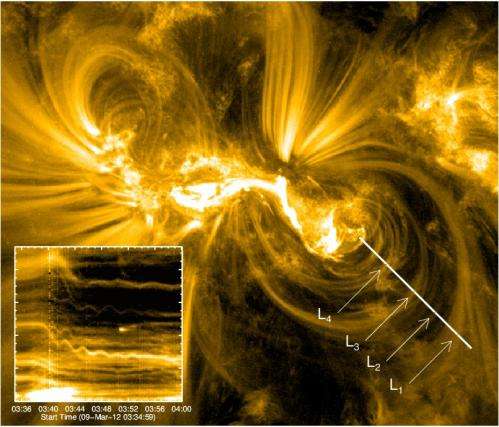Solar dynamic loops reveal a simultaneous explosion and implosion, plus evidence for magnetic reconnection

(Phys.org) —Movies of giant loops projecting from the surface of the Sun are giving new insights into the complex mechanisms that drive solar flares and Coronal Mass Ejections (CMEs). These eruptions release vast energy and electrically charged particles that can affect the Earth through space weather. Imagery from NASA's Solar Dynamics Observatory (SDO), used in two separate studies, shows the dynamics of loops before, during and after eruptions. Results have been presented at the National Astronomy Meeting in St Andrews.
Coronal loops are giant magnetic arches filled with hot plasma at temperatures of over a million degrees Celsius. The structures are anchored in the dense photosphere, the visible surface of the Sun. The loops form the building blocks of the corona, the halo surrounding the Sun that can be seen during a total eclipse. They are dynamic structures that oscillate back and forth after explosive events such as solar flares.
Researchers from the University of Glasgow observed four groups of loops that contracted rapidly during a flare on 9 March 2012. The loops had a 'staggered start' to their collapse, showing delays of 60–80 seconds from the inner to the outer loops.
"This event is a great example of a simultaneous implosion and explosion," said Dr Paulo Simões. "Our interpretation is that energy is transferred from the magnetic field to power the flare, leaving a pocket of reduced magnetic support that causes an implosion. The staggering between the loop contractions is caused by the time delay needed for the 'information' about the loss of support to travel outwards."

The loop contractions are triggered at the same time as the flare begins emitting intense X-rays and microwaves. The three outer loops show clear oscillations even as they contract, with distinct periods and phases. After being compressed by the collapsing loops, the flaring loops oscillate until they find a new equilibrium, as indicated by the X-ray emission from the hot plasma. During the contraction a wave blast revealed by extreme ultraviolet radiation spreads away from the source of the flare.
"This presents an intriguing picture of how magnetic energy is moved rapidly around the solar corona during a flare," said Dr Simões.
Flares and CMEs are thought to be driven by a process called magnetic reconnection, in which magnetic field lines in plasma break and then re-join to field lines flowing in the opposite direction. Energy that has built up over days or months is released in just a few minutes.
In a separate study, a team from the University of Warwick has observed the first evidence that loop oscillations are driven directly by magnetic reconnection processes.
"The structure and dynamics of the solar corona can be imaged in exquisite detail and over an unprecedented range of temperatures by SDO. Oscillating loops are a useful tool for probing conditions in the corona. This offers a unique opportunity to discover the tell-tale signatures of magnetic reconnection," said Rebecca White, who presented the findings on Tuesday 2nd July.
The Warwick team used SDO data to study the behaviour of loops following two eruptions: a CME on 3 November 2010 and a solar flare on 8 May 2012. With the first eruption, they saw a coronal loop form below the bubble of material ejected during the CME. There appeared to be a strand connecting the CME with the top of the loop. Unusually, parts of the loop were observed to oscillate in different directions about a central pivot point.
"The loop appears to twist about a fixed point along its length. Not only is the form of this oscillation highly unusual but the coronal loop has a temperature of between 9 and 11 million degrees - this is much hotter than most loops we see, which are generally between 1 and 3 million degrees. This extreme heat has been generated by the reconnection processes," said White. "For the first time we can see a direct link between the reconnection process itself, causing the formation of the loop below the ejected bubble, and the oscillations of the loops."
The second observation showed two separate but adjacent loops oscillating in opposite directions to one another. Previous observations have shown loop oscillations caused by blast waves emanating from the flare, however this pushes the loops in a single direction.
"Again, this cannot be explained by a blast wave since this would push both loops in the same direction. We think that the oscillations here are a direct result of the flare reconnection process changing the structure of the corona between the loops and sucking them towards each. These observations demonstrate that loop oscillations are a valuable tool for studying 3D reconnection processes at work," said White.
More information: R.S. White, E. Verwichte & C. Foullon, First observation of a transverse vertical oscillation during the formation of a hot post flare loop, A&A, 545, A129 (2012)
Provided by Royal Astronomical Society




















